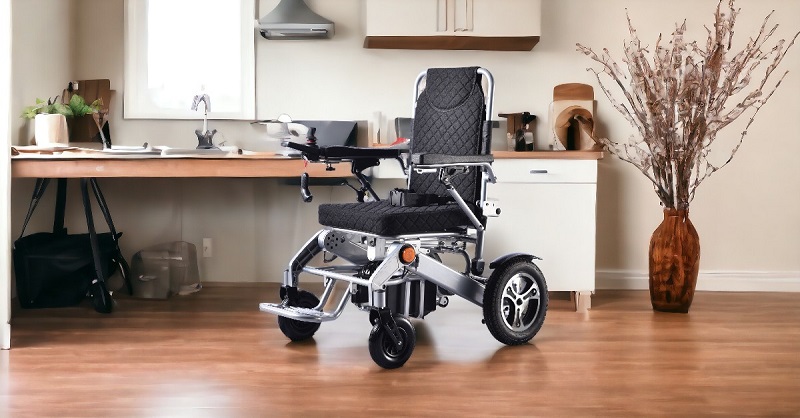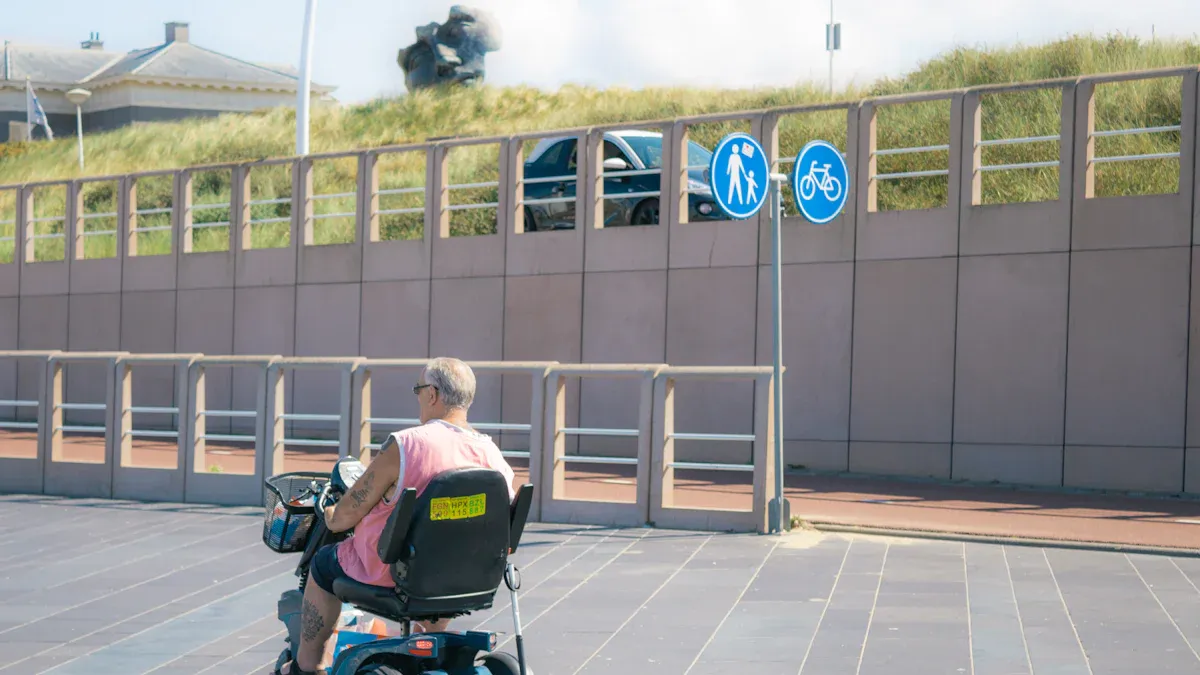Have you ever struggled with folding a wheelchair and felt unsure how to do it properly? There’s a simple technique that makes this task much easier. Our guide will show you the right steps to collapse your manual or electric wheelchair quickly and safely.
Keep reading – we’ve got the tips you need!
Types of Wheelchairs and Their Folding Mechanisms
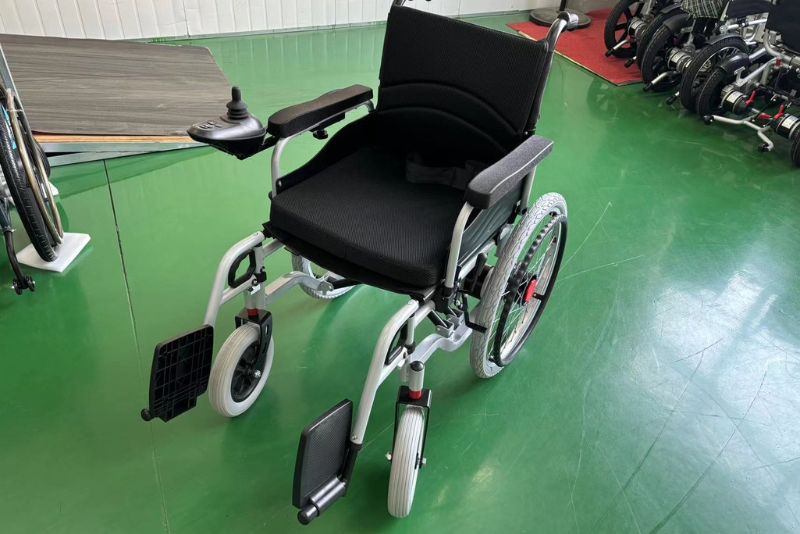
Wheelchairs come designed with user needs in mind, each featuring a unique folding mechanism that caters to either manual or electric mobility solutions. Understanding these mechanisms is key for effortless collapse and seamless transport, ensuring the chair’s longevity and the user’s convenience.
Manual Wheelchairs
Manual wheelchairs come in different styles and designs. They are made for people to move on their own or with help. You can take off parts like the seat cushion, footrests, and armrests when folding them up.
Rigid frame models let you pull off the rear wheels quickly. The backrest folds down too, making it super compact for travel or storage.
For moving and keeping a manual wheelchair, there’s a special method to follow. First, put on the wheel locks so it doesn’t roll away. Then you fold down the back and take out the rear wheels if needed.
They’re built to make this easy, so you can pack them up fast when it’s time to go somewhere or put them away.
Electric Wheelchairs
Electric wheelchairs provide comfort and are easy to take places. They come in full size, travel, and heavy-duty models to fit different needs. Some have an indirect drive, while others use a direct drive system.
Power chairs that fold up mix convenience with cozy seating choices.
Folding electric wheelchairs are simple designs making wheelchair storage easier. Users enjoy the freedom they offer for moving around and packing away their chair when it’s not needed.
Safety is also a top concern; experts study the risk of tipping over to create better protection systems in these chairs. With locking bars and secure caster wheels, transport wheelchairs help keep people safe as they go about their day.
Step-by-Step Guide for Folding a Manual Wheelchair
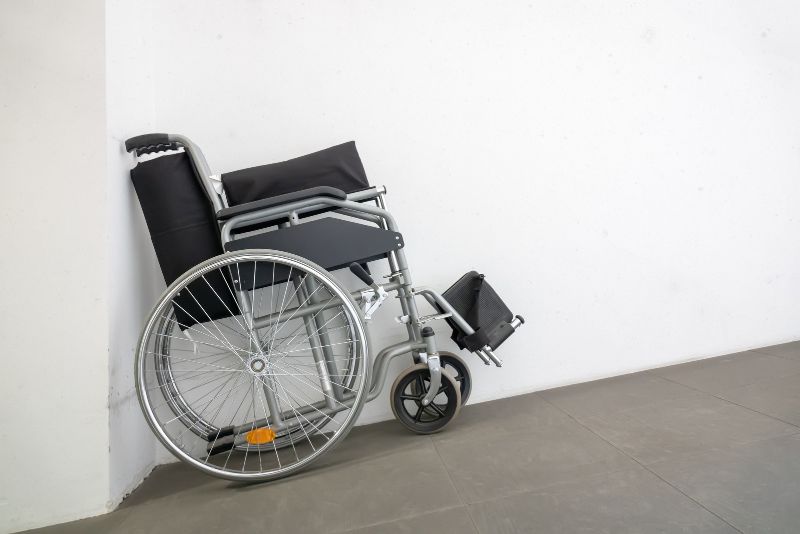
Ready to make transport and storage a breeze? Dive into our clear-cut guide that breaks down the essentials of unfolding and folding a manual wheelchair — step by easy step. Whether you’re prepping for travel or saving space at home, mastering this skill will add efficiency to your routine, no matter the type of chair your email inbox has been buzzing about since your latest healthcare diagnosis.
Let’s get started!
Preparing the Wheelchair
Before folding a wheelchair, make sure it’s ready. Check for any loose items that might fall off.
- Ensure the brakes are locked to keep the chair still.
- Remove any cushions or personal items from the seat.
- Tuck away straps or belts so they won’t get caught in the folding mechanism.
- Look over the chair and take off any removable parts like footrests or armrests.
- Double-check that all quick-release mechanisms are free from obstructions.
- Make certain the wheels are clean, as dirt can hinder the folding process.
- Confirm that folding levers or buttons aren’t stuck and move freely.
- Keep your fingers away from areas where they could get pinched during folding.
Collapsing the Wheelchair
Folding a wheelchair is simple. It makes transport and storage much easier.
- Stand at the front of the wheelchair.
- Lock the brakes to keep the wheelchair steady.
- Fold down the footrests or swing them to the side.
- If there’s a seat cushion, remove it and set aside.
- Press down on the levers located on the backrest.
- Lean over and grab both sides of the chair by its seat rails.
- Slowly press down firmly to guide the seat to collapse.
- Push both armrests together if they’re not locked in place.
- Ensure all parts are secure so nothing swings out during transport.
Storing the Folded Chair
Storing a folded wheelchair makes it easier to handle and saves space. Here’s how you can store it properly:
- Find a dry and clean area for the wheelchair to avoid damage from moisture or dirt.
- Make sure the seat of the chair is fully folded inward, aiming for a flat shape.
- Secure any loose straps or cushions to prevent them from dragging or getting caught.
- Place the wheelchair in its designated spot, such as a closet or the trunk of a car.
- Ensure nothing heavy is placed on top of the folded chair to keep it from bending or breaking.
- Check that all movable parts are locked in place so they don’t shift while stored.
Tips for Folding and Transporting Wheelchairs
Navigating the nuances of wheelchair transport can elevate your mobility game to new heights. With insight on securing loose components and savvy lifting techniques, you’re set to handle your chair with confidence and care.
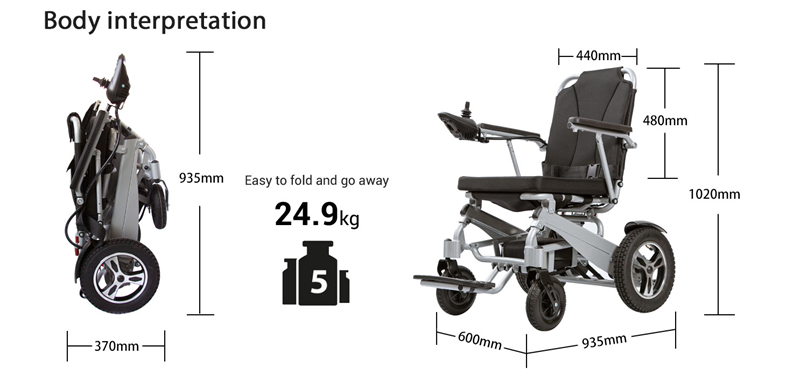
Check User Manual
Every wheelchair is different, just like cars. Before folding yours, grab the user manual. It has all the steps tailored for your model. This safety guide makes sure you do everything right and keep the wheelchair in top shape.
Lost the booklet? No problem! You can often find these guides online by searching for your wheelchair’s brand and model number. Don’t guess how to fold it; look up the exact method and follow it closely to avoid any damage or issues.
Secure Loose Parts
Before you fold the wheelchair, make sure all small parts are tight. Check nuts, bolts, and spokes. Loose spokes can cause trouble when pushing the chair. They may even make the wheel break down.
Fix any loose bits to keep your trips safe.
Keep an eye on parts that wear out over time too. Regularly fixing and swapping old parts keeps the chair working well. This way, it stays safe for those who rely on it every day. Always secure everything before folding or moving the wheelchair!
Use a Ramp or Assistance
Folding a wheelchair might need some help, especially if it’s heavy or awkward to handle. Ask someone strong to lift it for you, and remember using your legs to keep balance when going down a ramp.
Keep in mind that verbal prompts can guide the person who uses the wheelchair on what to do next.
Portable ramps make moving wheelchairs easier. They are light and simple to move, which is great for people who travel often or live in rentals. For vans with wheelchairs, manual ramps fold up quickly too.
These save you from dealing with hard maintenance that built-in ramps sometimes need.
Consider Lightweight Wheelchair Options
Lightweight wheelchairs are great for folding and carrying. They make traveling much easier. Some come with special features like ergonomic seating for extra comfort. These chairs don’t weigh much, so you can move them around quickly.
Learn more :How Much Does An Electric Wheelchair Weigh
Transport chairs are another good choice. They’re made to be easy to take on trips. Their design is compact, so they fit well in car trunks. If you often need to store or move a wheelchair, these might work best for you.
Lightweight models fold up fast, saving time and effort.
Folding a wheelchair is simple with the right steps. Always make sure it’s on a flat surface and locked in place. Grab the seat from the front and back to lift. Press down on the levers, lower footplates, unlock both sides, and fold away.
Master these moves for easy transport and storage!
FAQs
1. What do I need to do first to collapse a wheelchair?
First, make sure the brakes are locked and the footrests are removed or swung away.
2. Is it possible to unfold and fold a wheelchair with one hand?
Most wheelchairs require both hands to fold them safely.
3. Should the seat cushion be removed before collapsing a wheelchair?
Yes, take off the seat cushion before folding the chair.
4. Is it easy to collapse all types of wheelchairs?
Some wheelchairs may be harder to fold; always check your user manual for specific instructions.
5. After collapsing my wheelchair, will it fit in my car trunk easily?
Most collapsed wheelchairs should fit in a car trunk, but check your model’s size just to be sure.


